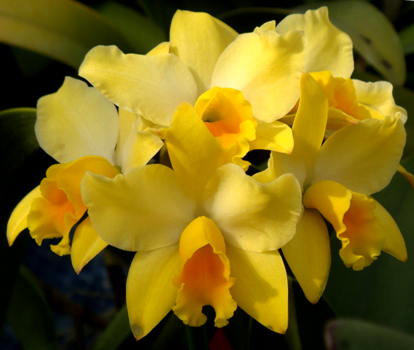March, 2019


Everybody Loves Rhyncattleanthe Love Sound:
Every so often a Cattleya hybrid catches everyone's fancy, leading to a flood of new hybrids as orchid growers try to create something even better. So it was with Cattleya Bow Bells (Black & Flory, 1945), Cattleya Bonanza (Bracey, 1949), and Cattlianthe Chocolate Drop (Stewart, 1965). One of the latest stars of the orchid world is Rhyncattleanthe (Rth.) Love Sound, registered in 1987 by Dogashima, and now the parent of at least 154 new hybrids.
Dogashima Orchid Sanctuary, which had a research center, has now apparently morphed into Orchid Resort Dogashima, on the scenic Izu peninsula in Japan. At least a few years ago, the research center was active in the field of orchid micropropagation. The cultivar name 'Dogashima' is attached to about a dozen other hybrids as well.


Whether all the cultivars of Love Sound are the result of a single cross, or if instead there have been one or more remakes, we don't know. Love Sound itself is C. briegeri (formerly a "rupicolous Laelia", sometimes a Sophronitis, and then briefly and perhaps still, for some people who really like double letters, Hoffmannseggella briegeri — but now, after the latest taxonomic upheaval, a Cattleya) crossed with an extremely complex Rhyncattleanthe Bouton D'Or, which has a total of 14 species in its pedigree, including three more from the old "rupicolous" group.


Love Sound cultivars are mostly yellow with lighter shading along the middle of the petals, with deeper tones and often also a reddish blush on the lip. Some have subtle reddish flares or shading on the margins of the petals and sepals. The form is usually good, and the flowers last well. As a parent, Love Sound transmits these characteristics to most of its progeny.


Among the Love Sound hybrids, of course, is the inevitable cross with Cattlianthe Chocolate Drop, which turned out quite nice, with a total of 13 AOS awards so far, Rhyncattleanthe Brassy Gold. While most of the hybrids have produced yellows or peach tones, often with a red lip, there have been some exceptions. Several have produced semi-alba seedlings (e.g., Hsinying Catherine). Izumi Charm (two awards) came out with very pale yellows and a deep crimson lip. And we can't leave out Martha Clarke, now with at least 10 awards, and a wide range of hot colors, flares, and extremely full petals.


The Love Sound hybrids are still coming to market. Fred Clarke's current seedling list includes many new first and second generation Love Sound hybrids. With a proven record of excellent plants from this line of breeding, we will probably hear more from those seedlings in coming years. Who will find the next big winner? Maybe you?
Here are some of those plants that got past hybridizers so excited:


